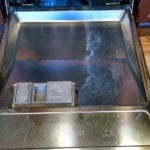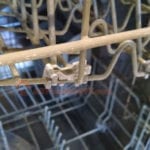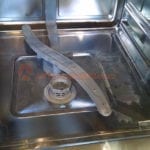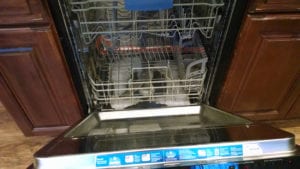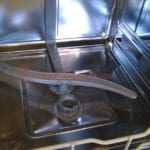With 2 young children around, my dishwasher gets pretty dirty after repeated use (especially since I have hard or mineral rich water in my house).
You can see the soap buildup and stains on the “stainless” tub as well as white powder like substance on racks, rollers, etc. All these things make dishwasher components to work harder to operate.
Although if the stains are pretty bad, I use the Magic Cleaner, I generally do not like to use chemicals to clean appliances for 2 reasons:
Reason # 1 – byproduct (i.e. waste water) unnecessarily adds to our pollution problems;
Reason # 2 – repeated use of chemicals may degrade plastic components inside a dishwasher;
So what is the solution? A good old cheap, distilled and/or white Vinegar!
All I do is have 2 glasses with straight vinegar and position them (one on the top rack, one on the bottom rack) like you see here:
Please note the extra glass on the bottom is used as a bracing to prevent the vinegar glass from tipping over. I also tip the utensil racks to ensure the maximum exposure to sloshing water.
With vinegar in place, I run a sanitary cycle once and, this is the important part, I run a regular cycle without anything inside to washout any vinegar residue sitting inside a circulation pump and drain pump.
My residue was so gunky that after one cycle, there were lots of foam inside the tub so I ran it another time.
Overall, it takes about 2 hours to clean. The result is a clean, stain-free dishwasher with easy rolling racks!
Thanks for reading and good luck with your DIY project!


